Content
Published:
This is an archived release.
Population growth in foreseeable future
The Norwegian population will continue to grow throughout the century, according to the medium alternative in the population projections. The growth will be particularly high in and around the larger cities. The aging of the population will continue, and every fifth resident in Norway will be at least 70 years of age in 2060.
| Registered 20131 | Projected MMMM2 | |||
|---|---|---|---|---|
| 2020 | 2040 | 2060 | ||
| 1Total population registered per January 1 2014. | ||||
| 2Each alternative is described by four letters in the following order: fertility, life expectancy, internal migration and immigration. M = medium, L = low and H = high. | ||||
| 3The projections calculate life expectancy based on age at the end of a year and not age at time of death, resulting in slightly different estimates from those presented in the general population statistics. | ||||
| 4The numbers for immigration and emigration in the projections do not include multiple moves to and from Norway during the same year for an individual. The numbers are thus lower than the immigration and emigration numbers in the general population statistics. The numbers for net migration are, however, comparable. | ||||
| Total population | 5 109 056 | 5 450 106 | 6 323 563 | 6 868 230 |
| Deaths | 41 282 | 42 463 | 56 443 | 65 674 |
| Life expectancy at birth men3 | 79.6 | 80.7 | 83.7 | 86.5 |
| Life expectancy at birth women3 | 83.5 | 84.5 | 87.0 | 89.1 |
| Live births | 58 995 | 66 664 | 68 762 | 72 790 |
| Total fertility rate | 1.78 | 1.82 | 1.80 | 1.80 |
| Immigration4 | 72 689 | 64 746 | 56 207 | 53 986 |
| Emigration4 | 32 636 | 35 592 | 37 041 | 36 792 |
| Net migration | 40 053 | 29 154 | 19 165 | 17 193 |
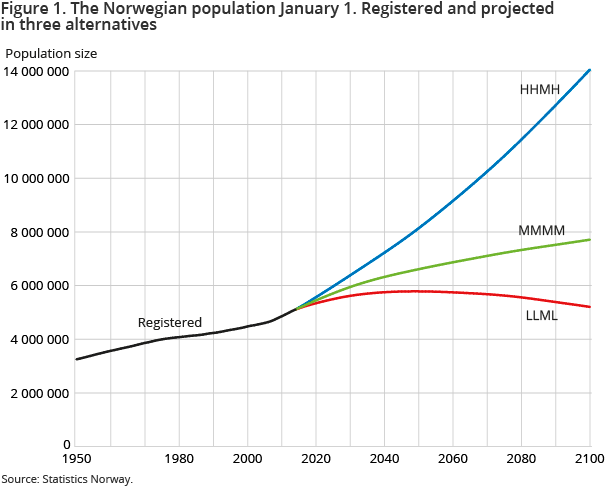
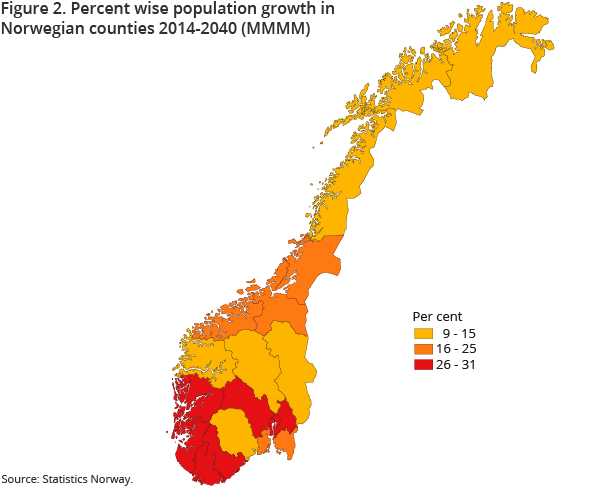
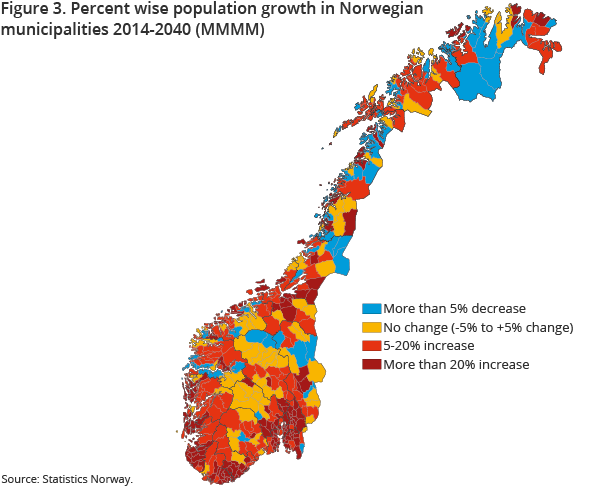
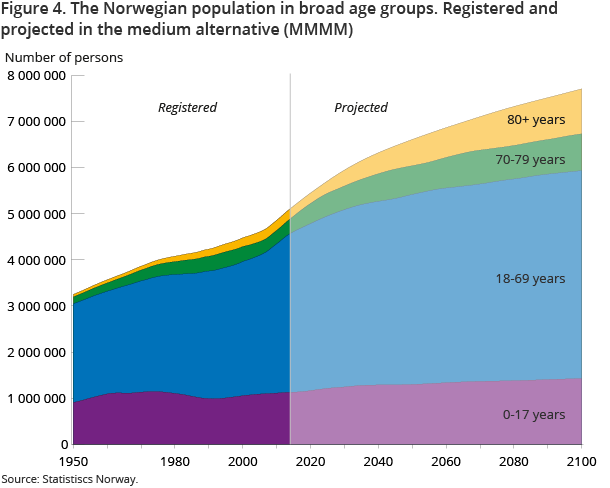
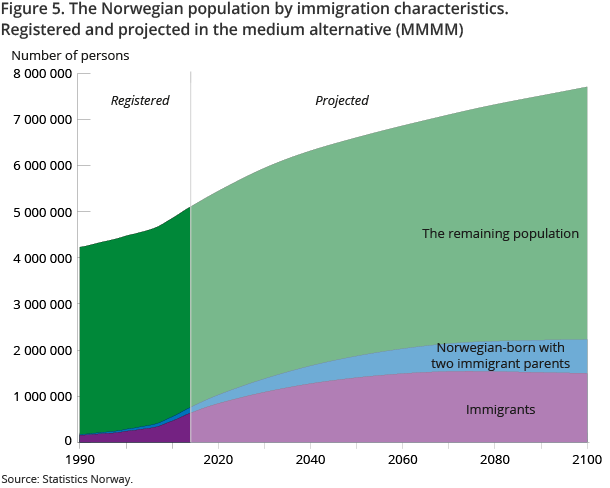
Statistics Norway’s population projections publish several different alternatives for the future development of the size and composition of the population of Norway. The medium alternative MMMM is our main alternative, and in this alternative we assume a medium development in fertility, life expectancy, domestic migration and immigration. Presented figures and numbers refer to this alternative unless otherwise noted.
The high growth we have witnessed in recent years will gradually slow down. Nevertheless, the Norwegian population will continue to grow throughout the century, as shown in Figure 1. We will reach 6 million inhabitants in 2031 and 7 million in 2065.
In our main alternative, we have assumed that fertility in the long term will remain stable at around 1.8 children per woman, that life expectancy will increase for all ages, but somewhat more sharply for men than women, and that net migration will remain relatively high, in particular during the first half of the projection period. A summary of the assumptions underlying the current projections is shown in the table above.
A more thorough discussion of each component is included in separate articles. Unfortunately, these articles are only available in Norwegian:
Alternative assumptions result in wide variation
Figure 1 also portrays the development if we assume different levels of fertility, life expectancy and immigration. In the low national growth alternative LLML , denoted ‘low’ for short, the population will continue to grow for a few more decades, but from 2050 onwards it will begin to decline, and Norway will not reach 6 million inhabitants in this century. In the high national growth alternative HHMH , denoted ‘high’ for short, the Norwegian population will reach 8 million in 2048 and 10 million in 2067.
Population decline in EU
In a European context, population growth is not an apparent expectation in the foreseeable future. Many European countries, including the Baltic States, Bulgaria, Germany, Romania, Greece and Portugal, have already experienced a population decline. Earlier this year, Eurostat released new population projections for Europe. According to their main alternative, the population growth for the 28 member countries will come to a halt, and from 2050 onwards the EU population as a whole will decline for many decades.
Most pronounced growth in and around the largest cities
We project the population in counties and municipalities up to the end of 2040. According to our main alternative, all counties will experience population growth during this period. As shown in Figure 2, the population growth will be most pronounced around Oslo and in the Southern and Western parts of Norway. The counties of Akershus, Oslo and Rogaland will see the largest growth, whereas Sogn and Fjordane will experience the lowest growth.
In the main alternative, the population will remain relatively stable (± five per cent change from 2014 to 2040) in 75 of Norway’s 428 municipalities. A total of 294 municipalities (69 per cent) will have a more numerous population in 2040 compared to today, whereas 59 municipalities will experience a population decline. Figure 3 shows a map indicating the municipalities that will remain relatively stable, grow or decline. In the low alternative, many more municipalities will experience a population decline: nearly one third (135/428) of the municipalities will have fewer inhabitants in 2040 compared to 2014, whereas a little less than half (202/428) of the municipalities will experience growth. In the high alternative, more than 90 per cent (391/428) of the municipalities will grow, and only 14 will decline.
Norway is commonly broadly divided into six geographic regions: East, South, South-West, West, Mid and North. Each region has a regional ‘centre’. The population in all six regional centres, i.e. Oslo, Kristiansand, Stavanger, Bergen, Trondheim and Tromsø, will increase markedly. According to the main alternative, Oslo will reach 700 000 inhabitants in 2020, whereas Bergen and Trondheim will reach 300 000 and 200 000 inhabitants in 2024 respectively.
Even though the regional centres will experience a pronounced population growth, the growth will appear to be even sharper in the municipalities immediately surrounding these centres. Of the 20 municipalities with the highest percentual growth, 18 are situated in close proximity to a regional centre. More specifically, this applies to Rennesøy, Hå, Klepp, Gjesdal and Bjerkreim outside Stavanger; Meland, Os, Fjell, Austevoll, Askøy and Austrheim outside Bergen; Skaun near Trondheim; Ås, Våler, Hobøl, Ullensaker, Sørum and Hole close to Oslo.
Every fifth person will be 70 years or older
The number of adults and elderly will increase sharply over the coming decade, as illustrated in Figure 4. The increase will be particularly sharp among the elderly aged 70 and over. According to our main alternative, this group will double in size over the next 30 years as a consequence of the large cohorts born immediately after WWII growing old, and increases in remaining life expectancy for older age groups. The age group 70 and older constitutes 11 per cent of the population today, but will increase to around 19 per cent in 2060. As a consequence, every fifth person in Norway will be 70 years or older in 2060.
The most elderly will also make up an increasingly large share of the population. The proportion of 80-89 year-olds currently constitutes 3.4 per cent, but will increase to around 7.0 per cent in 2060. The proportion who are 90 years or older will triple – from 0.8 per cent today to 2.5 per cent in 2060. In total, individuals aged 80 and older will thus make up almost one tenth of the population in 2060, compared to 4 per cent today.
More immigrants
Annual net migration to Norway has been stable at around 40 000-50 000 individuals for the last couple of years, which is a substantial rise compared to the situation in previous decades. According to our main alternative, immigration to Norway is assumed to decline somewhat in the long run, while emigration will increase somewhat – especially over the first few years. As a consequence, net migration will decline in the long run. In this alternative, net migration will stabilize at around 15 000-20 000 individuals per year from 2040 onwards. In the high immigration alternative MMMH , net migration will continue to increase throughout the majority of the period. In the low immigration alternative MMML , the net migration slows down and stabilizes at around 5 000 individuals per year, but remains above zero at all times (i.e. we have a surplus of immigrants also in this alternative).
As a consequence of the positive net migration throughout the projection period, the number of immigrants residing in Norway will increase. This also applies to Norwegian-born children of two immigrant parents. Figure 5 shows how the composition of the population will develop according to our main alternative, broken down into immigrants, Norwegian-born children of two immigrant parents and the remaining population. The total number of immigrants will increase from around 630 000 today, to around 1.5 million in 2060, and then stabilize. The number of Norwegian-born children with two immigrant parents will increase from around 126 000 today, to around 400 000 in the early 2040s, which corresponds to a tripling in less than 30 years, and will continue to rise throughout the projection period.
Immigrants from Asia, Africa, Latin America and Eastern Europe outside of the EU comprise the largest group of immigrants in Norway today, and according to our main alternative this group will also dominate in the future. However, a larger share of immigrants will have long stays in Norway: in two decades, the majority of immigrants will have lived in Norway for 16 years or more.
According to our main alternative, immigrants will comprise around 22 per cent of the total population in 2060, while 8 per cent will be Norwegian-born children of two immigrant parents. According to the low immigration alternative, the corresponding figures for 2060 will be 19 and 7 per cent respectively. In the high immigration alternative, immigrants will comprise 31 per cent of the population in 2060, while Norwegian-born children with two immigrant parents will comprise 10 per cent of the population in 2060. These latter shares will continue to rise to around 33 and 14 per cent in 2100.
Pronounced uncertainty
It is difficult or rather impossible to accurately project the future. There is thus a high degree of uncertainty in the projected figures on how the population will develop in the future, both with regard to total size and composition. This is reflected in the pronounced variation between the different projection alternatives. This variation underlines the importance of the assumptions made with regard to future fertility, life expectancy and immigration. In our projections, there is pronounced uncertainty in the assumptions made for immigration in particular. However, it may transpire that future fertility, domestic migration, emigration and mortality also see a different development to that assumed in our projections. The uncertainties in the population projections increase with time as it is more difficult to predict the long-term than the short-term future. Furthermore, the projected figures are less reliable for smaller sub-groups, such as projected numbers of inhabitants in individual municipalities by sex and one-year age groups.
Regional projectionsOpen and readClose
In the projections of the population at county and municipal levels, we assume that the regional developments in fertility, life expectancy and domestic migration that have been observed over the last five years before the projection will continue. This means that we have not taken into account factors such as plans for or actual downsizing of local industries, new work places, future developments in transportation, housing, schools etc. In the documentation report, also available in English, certain aspects related to the regional projections are discussed in more detail.
ComparabilityOpen and readClose
The figures from the various tables from the population projections do not always tally. This is partly because the figures are rounded off at different levels, but mostly because two different models are used in the projections (one national and one regional), and the results from the individual components are not fully calibrated.
The definitions of age and migration are somewhat different in the population projections compared to the definitions applied in the regular population statistics, and as a result, comparable figures in the projections and the population statistics may differ slightly. This applies in particular to life expectancy, immigration and emigration. Net migration is, however, similarly defined. For more information on comparability, please refer to the documentation report on the population projections.
Contact
-
Statistics Norway's Information Centre
E-mail: informasjon@ssb.no
tel.: (+47) 21 09 46 42
-
Inquiries about national projections
E-mail: nasjfram@ssb.no
-
Inquiries about regional projections
E-mail: regfram@ssb.no
-
Michael Thomas
E-mail: michael.thomas@ssb.no
tel.: (+47) 40 90 26 28
-
Ane Margrete Tømmerås
E-mail: ane.tommeras@ssb.no
tel.: (+47) 91 99 29 62
